
Manuel de Falla’s La Vida Breve makes its video debut with this release
from C-Major which means there’s still plenty of opportunities for improvement. De Falla completed what is considered to be Spain’s national monument to opera when he was 28 years old in 1905. Its premiere took place, naturally, in Paris in 1913 after his gifts were championed by the likes of Ravel, Debussy and Dukas.
With a performance time of a slim hour and twenty minutes it tells the story of the gypsy girl Salud who’s in love with Paco. He’s already betrothed to another of his class and even with his wedding day fast approaching, like in the very next scene, he’s still enjoying Salud’s favors. Her Grandmother and Uncle stand by commenting on the action, keening at Salud’s fate and hurling curses and oaths in Paco’s general direction.
You don’t need to have seen the last act of Carmen to know that things aren’t going to end well when you spurn the Spanish. Salud denounces Paco as a cad in front of the entire wedding party and then fatally succumbs to her own bile and ire on the spot like all good sopranos should.
This performance comes from the Palau de les Arts Reina Sofia in Valencia and luckily carries with it the full flavor of its Iberian birthright in spite of an American conductor, Italian director and a Chilean soprano in the lead.
Giancarlo del Monaco directs and designs a starkly evocative and very abstract performance that nearly works but turns out to be just a little too Regie for its own good. First off, it’s red. Not just a little either. A red setting on a red stage lit with red lights. Looming red stuccoed walls with doors cut in them that never open but that do bend and flex to form halls, rooms and a large gate. A few chairs scattered downstage left and precious few other props to suggest time or place. So, when our lovers finally meet in the first scene they’re down on the floor on top of each other right in front of Grandma. Not pretty.
The best visual effect of the evening comes with the transition to the Act II wedding and the arrival of the evening’s entertainment. A flamenco singer, made up to look like our heroine Salud, riding a crucifix into the wedding party on a cloud of stage fog with a guitarist at her feet. Subtle. The overwhelming heat of Granada is evidenced by the most enormous ceiling fan I’ve ever seen apparently left behind by the Spanish touring company of Miss Saigon. As the fatal denouement approached the blades of the fan actually start lowering closer and closer to the stage until I feared the director would put an entirely new ‘spin’ on De Falla’s class conscious finale.
But that wasn’t the most disturbing technological development on stage. From the first moment of the principals singing I was struck by both the clarity and the odd lack of acoustic on the voices. Then I spotted it sticking out over Grandma’s ear… a Broadway style body mic. All the principals had one. Our soprano’s was tucked cleverly into the flower in her hair.
I don’t know if they were using them solely for the use of recording but I have to say by leveling the sound field in this manner you completely lose the individual size of each voice as well as its relation to its partners on the stage. I then amused myself momentarily with thoughts of some innocent soundboard operator positioning one on Birgit Nilsson or Gwyneth Jones and his subsequent trip to ICU after his ears had exploded. But I digress.
Our Iberian zingara of the evening is played by Cristina Gallardo-Domâs. I have long been a fan of this soprano since I first heard her on recording as Puccini’s Suor Angelica and then later, on video, in a most excellent Boheme in the old Scala production that was the first time I have ever been emotional at “O soave fancuilla” in Act I. If you don’t mention her recording of Aida for Harnoncourt, neither will I. Deal?
She inhabits this role with all its naive angst and, finally, heartbreak in exactly the way her character should in this context. The particular latin silver in her sound and her Incan Princess looks are perfect even if she does develop a beat on the very top notes once or twice. She throws herself headlong into this portrayal and while the character of Salud is more of a novice than say, Santuzza or certainly Carmen you can see the similarities more than the differences.
As her La Abuela, Maria Luisa Corbacho wields a powerful mezzo that starts out all Mama Lucia and ends the opera like an Andalusian Erda on her knees at the front of the stage reading fate on a set of black cards with no suits or faces. Ah, more subtlety.
Tenor Jorge de León as Paco makes a good showing in his brief duet in the first act with Salud but an even bigger impression in the toreador pants during the wedding party scene. He’s chubby and a little seedy looking but has a strong voice. The camera operators do their best to shoot him from the waist up in Act II.
Uncle Sarvaor is taken by bass Felipe Bou and he makes the most of all his curses and colloquial maledictions against Paco with a dark pointed sound that I think I would have enjoyed hearing more without the body mic.
The one enormous break with tradition in this production is the casting of the flamenco singer in the wedding party as a woman instead of a man, though Esperanza Fernández does such a magnificent job that I don’t think de Falla himself would have minded. She’s accompanied beautifully by guitarist Juan Carlos Gómez Pastor and for those of us who really enjoy the idiom it’s the highlight of the evening.
The elegant costumes by Jesus Ruiz and hairstyles all look to be about late 1920’s which is just about right and, naturally, everyone has a fan going during the party. The quality of choreography of the justly famous dances in Act II doesn’t come close to surpassing the music but, how could it ?
Lorin Maazel does stunning work in the pit with the Orquestra de la Comunitat Valenciana and they render all of de Falla’s potent melismas and arching themes as to the manner born. It’s one of those scores you feel like you know because so much of it is familiar out of context.
It honestly looks like the video director, Tiziano Mancini, had little experience with the production prior to filming because some of the bigger effects of the staging seem to be caught up to rather than framed, which is a shame. Clarity of picture is kind of hampered by the incessant red rendering of everything up until the closing pages of the score and I don’t think a Blu-ray would look any sharper than the DVD copy I’m reviewing.
Sound is DTS 5.1 but, once again, although it shows the orchestra to full advantage the extreme balance on the singer’s voices robs this performance, I think, of some of its most potent immediacy. Since the cupboard is bare this is the best we have for now and certainly enjoyable on many levels.














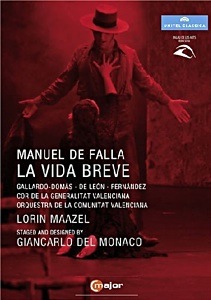
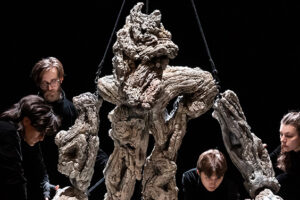
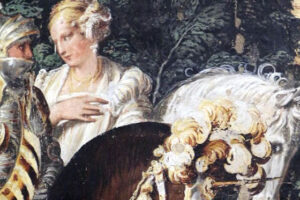
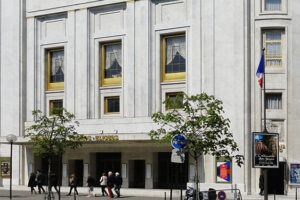
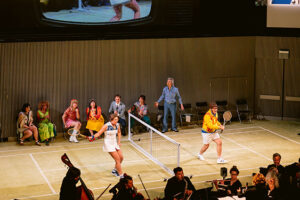






Comments